Portraits by Rubens
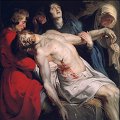 The Flemish and European
Baroque painter Peter Paul Rubens was the
most renowned northern European artist of his day, and is now widely
recognized as one of the foremost painters in Western art history. He
was the proponent of the Baroque style which emphasized
movement, color, and sensuality. By completing
the fusion of the realistic tradition of Flemish painting with the
imaginative freedom and classical themes of Italian Renaissance
painting, he fundamentally revitalized and redirected northern
European painting.
The Flemish and European
Baroque painter Peter Paul Rubens was the
most renowned northern European artist of his day, and is now widely
recognized as one of the foremost painters in Western art history. He
was the proponent of the Baroque style which emphasized
movement, color, and sensuality. By completing
the fusion of the realistic tradition of Flemish painting with the
imaginative freedom and classical themes of Italian Renaissance
painting, he fundamentally revitalized and redirected northern
European painting.
- Portrait of a Young Scholar (1597)
- Equestrian Portrait of Giancarlo Doria (1606)
- Portrait of Marchesa Brigida Spinola Doria (1606)
- Portrait of Maria Serra Pallavicino (1606)
- The Artist and His First Wife, Isabella Brant, in the Honeysuckle Bower (1610)
- The Four Philosophers (1612)
- Boy with Bird (1616)
- Portrait of Lady Arundel with her Train (1620)
- Marie de Medici, Queen of France (1622)
- The Straw Hat (1625)
- Portrait of Anne of Austria (1625)
- The Duke of Buckingham (1625)
- Albert and Nicolaas Rubens (1627)
- Portrait of Jan Gaspar Gevartius (1628)
- The Fur ('Het Pelsken') (1630)
- Helena Fourment (1632)
- Helena Fourment with her Son Francis (1635)
- Helena Fourment with her Children, Clara, Johanna and Frans (1637)
- Self-Portrait (1639)
Portrait of a Young Scholar (1597)
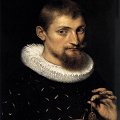 Get
Get  a high-quality picture of
Portrait of a Young Scholar for your computer or notebook. ‣
This is Rubens's earliest known painting. In its somewhat formal pose and pale flesh-tints of the face this painting is entirely in keeping with the earlier Netherlandish style of portraiture. None the less, the play of the hands in Rubens's portrait reveals a lively force that seems to announce a new type of portrait painting which would, however, only later come into is own.
a high-quality picture of
Portrait of a Young Scholar for your computer or notebook. ‣
This is Rubens's earliest known painting. In its somewhat formal pose and pale flesh-tints of the face this painting is entirely in keeping with the earlier Netherlandish style of portraiture. None the less, the play of the hands in Rubens's portrait reveals a lively force that seems to announce a new type of portrait painting which would, however, only later come into is own.
Equestrian Portrait of Giancarlo Doria (1606)
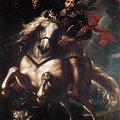 Get
Get  a high-quality picture of
Equestrian Portrait of Giancarlo Doria for your computer or notebook. ‣
Explicitly Venetian are the two large equestrian portraits Rubens made in his Italian period. The Mannerist emotiveness of the Duke of Lerma and of Giancarlo Doria with their typical foreshortenings and flickering light, is unthinkable without Tintoretto, from whom the composition is also derived. Yet unlike him, Rubens gives a strong impression physical presence and vitality to his aristocratic sitters.
a high-quality picture of
Equestrian Portrait of Giancarlo Doria for your computer or notebook. ‣
Explicitly Venetian are the two large equestrian portraits Rubens made in his Italian period. The Mannerist emotiveness of the Duke of Lerma and of Giancarlo Doria with their typical foreshortenings and flickering light, is unthinkable without Tintoretto, from whom the composition is also derived. Yet unlike him, Rubens gives a strong impression physical presence and vitality to his aristocratic sitters.
Portrait of Marchesa Brigida Spinola Doria (1606)
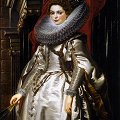 Get
Get  a high-quality picture of
Portrait of Marchesa Brigida Spinola Doria for your computer or notebook. ‣
The painting was done while Rubens was in Genoa in 1606. It was cut down from a full-length portrait in which the young Marchesa (age 22) appears in the porch of a villa. We know this from a study drawing for the portrait, which is in the Pierpont Morgan Library, New York.
a high-quality picture of
Portrait of Marchesa Brigida Spinola Doria for your computer or notebook. ‣
The painting was done while Rubens was in Genoa in 1606. It was cut down from a full-length portrait in which the young Marchesa (age 22) appears in the porch of a villa. We know this from a study drawing for the portrait, which is in the Pierpont Morgan Library, New York.
Portrait of Maria Serra Pallavicino (1606)
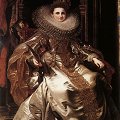 Get
Get  a high-quality picture of
Portrait of Maria Serra Pallavicino for your computer or notebook. ‣
This large portrait of a noble woman was executed by Rubens during his stay in Genoa.
a high-quality picture of
Portrait of Maria Serra Pallavicino for your computer or notebook. ‣
This large portrait of a noble woman was executed by Rubens during his stay in Genoa.
The fine full-length portraits of ladies from the highest social circles in Genoa possess a pronounced Venetian stamp. This port and trading city was governed by a city oligarchy, consisting of members of aristocratic families such as the Pallavicinis, Durazzos, Grimaldis, Imperiales and Spinolas, who controlled the banking, economy and politics of the republic. These members of Genoese urban aristocracy were painted by Rubens around 1606-07. The portraits have none of the courtly formality that was so characteristic of the Low Countries tradition of portraiture in the manner of Mor and Frans Pourbus II.
In portraits such as that of Maria Serra Pallavicino, the observer is struck by the high degree of realism. Rubens achieved this by a variety of means. He used interrupted backgrounds, where strategically placed porticos and pillars carry the eye of the observer into the distance; the brilliant suggestion of tangibility in the depiction of the costly satins worn by the ladies, the impression they give of arrested movement, and the presence of children dwarves and pets that enliven the decorum of the subject. It is evident that the similar portraiture of Titian, and even more, of Veronese, were the models here. The treatment of colour and light, particularly in the glowing dark red of the ceremonial curtain and the reflections illuminating the dark, mainly brownish, architecture like flashes of lightning, is influenced by Tintoretto's technique.
The Artist and His First Wife, Isabella Brant, in the Honeysuckle Bower (1610)
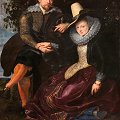 Get
Get  a high-quality picture of
The Artist and His First Wife, Isabella Brant, in the Honeysuckle Bower for your computer or notebook. ‣
In 1609 Rubens married Isabella Brant, daughter of the humanist and lawyer, Jan Brant, one of the secretaries of Antwerp. Shortly after his marriage, he lovingly portrayed himself hand-in-hand with his wife under a honeysuckle bower.
a high-quality picture of
The Artist and His First Wife, Isabella Brant, in the Honeysuckle Bower for your computer or notebook. ‣
In 1609 Rubens married Isabella Brant, daughter of the humanist and lawyer, Jan Brant, one of the secretaries of Antwerp. Shortly after his marriage, he lovingly portrayed himself hand-in-hand with his wife under a honeysuckle bower.
The Four Philosophers (1612)
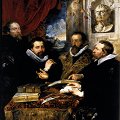 Get
Get  a high-quality picture of
The Four Philosophers for your computer or notebook. ‣
Portraits, including those in seventeenth-century Antwerp, were not just a mirror of the dominant ethical ideas of the time. They could also, in an equally subtle way, illustrate someone's intellectual role and significance. The group portrait known as the Four Philosophers, which shows Rubens with three humanists, his brother Philip, Johannes Woverius and the teacher of both of them, Justus Lipsius is a typical example. Emblematic details make it clear that Rubens has shown himself with the three humanists in order to express the underlying moral principles of Stoic philosophy, which were also those of the influential Lipsius and the other sitters. They are shown gathered together in homage to Seneca, one of the classical exponents of Stoicism, here represented by his bust. Finally, the ruins of the Palatine in the background show that the picture also pays homage to classical culture in the widest sense, symbolizing the resurrection in their own time of the departed glory of Hellenistic-Roman antiquity.
a high-quality picture of
The Four Philosophers for your computer or notebook. ‣
Portraits, including those in seventeenth-century Antwerp, were not just a mirror of the dominant ethical ideas of the time. They could also, in an equally subtle way, illustrate someone's intellectual role and significance. The group portrait known as the Four Philosophers, which shows Rubens with three humanists, his brother Philip, Johannes Woverius and the teacher of both of them, Justus Lipsius is a typical example. Emblematic details make it clear that Rubens has shown himself with the three humanists in order to express the underlying moral principles of Stoic philosophy, which were also those of the influential Lipsius and the other sitters. They are shown gathered together in homage to Seneca, one of the classical exponents of Stoicism, here represented by his bust. Finally, the ruins of the Palatine in the background show that the picture also pays homage to classical culture in the widest sense, symbolizing the resurrection in their own time of the departed glory of Hellenistic-Roman antiquity.
Boy with Bird (1616)
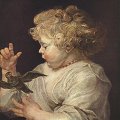 Get
Get  a high-quality picture of
Boy with Bird for your computer or notebook. ‣
A child of about two is shown playing with a captive bird. On the original panel, which was smaller, only the child's head was visible. Rubens made use of this study for an angel in the Madonna with a Floral Wreath in the Alte Pinakothek in Munich. Later the artist enlargened the picture on the left side, adding the hands with the bird.
a high-quality picture of
Boy with Bird for your computer or notebook. ‣
A child of about two is shown playing with a captive bird. On the original panel, which was smaller, only the child's head was visible. Rubens made use of this study for an angel in the Madonna with a Floral Wreath in the Alte Pinakothek in Munich. Later the artist enlargened the picture on the left side, adding the hands with the bird.
Although formerly taken to be a girl, the child portrayed is in all probability Rubens' first son Albert, who was born in 1614. The motif of the child playing with a bird goes back to antiquity. It also crops up frequently in Christian art. The bird symbolizes the soul or life, which passes all too quickly. In many pictures of the Virgin and Child, Jesus is portrayed holding a bird in his hand as an allusion to his death and resurrection. Whether Rubens had a similar allegory in mind when he introduced the bird into his child-portrait, or whether some particular incident in his own life motivated him, is not known.
Portrait of Lady Arundel with her Train (1620)
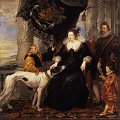 Get
Get  a high-quality picture of
Portrait of Lady Arundel with her Train for your computer or notebook. ‣
Venetian ideas were decisive for the development of Rubens's painting style. Increasing conformity to that example is also shown by the flamboyance which Rubens from c. 1620 onwards began to lend with such emphases to his official portraits of foreign princes and aristocrats. The most remarkable example is perhaps is the Portrait of Lady Arundel with her Train.
a high-quality picture of
Portrait of Lady Arundel with her Train for your computer or notebook. ‣
Venetian ideas were decisive for the development of Rubens's painting style. Increasing conformity to that example is also shown by the flamboyance which Rubens from c. 1620 onwards began to lend with such emphases to his official portraits of foreign princes and aristocrats. The most remarkable example is perhaps is the Portrait of Lady Arundel with her Train.
Both the picturesque embellishments added to this great portrait of the eccentric English countess, with her jester, her dwarf and her dog, and the theatrical baldachin and the view over open country, are typical of Titian's style. It should be remembered that the Earl and Countess of Arundel had strongly Venetian-inspired artistic ideas.
Marie de Medici, Queen of France (1622)
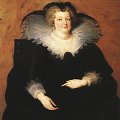 Get
Get  a high-quality picture of
Marie de Medici, Queen of France for your computer or notebook. ‣
Marie de Medicis (1573-1642), queen consort of King Henry IV of France (reigned 1589-1610) and, from 1610 to 1614, regent for her son, King Louis XIII (reigned 1610-43).
a high-quality picture of
Marie de Medici, Queen of France for your computer or notebook. ‣
Marie de Medicis (1573-1642), queen consort of King Henry IV of France (reigned 1589-1610) and, from 1610 to 1614, regent for her son, King Louis XIII (reigned 1610-43).
Marie was the daughter of Francesco de' Medici, grand duke of Tuscany, and Joanna of Austria. Shortly after Henry IV divorced his wife, Margaret, he married Marie (October 1600) in order to obtain a large dowry that would help him pay his debts. In 1601 Marie gave birth to the dauphin Louis (the future Louis XIII), and during the following eight years she bore the king five more children. Nevertheless, their relationship was strained. Marie resented Henry's endless infidelities, and the king despised her unscrupulous Florentine favourites, Concino Concini and his wife Leonora. Upon the assassination of Henry IV (May 14, 1610) the Parlement of Paris proclaimed Marie regent for young King Louis XIII.
Guided by Concino (now the Marquis d'Ancre), Marie reversed Henry's anti-Spanish policy. She squandered the state's revenues and made humiliating concessions to the rebellious nobles. Although Louis XIII came of age to rule in September 1614, Marie and Ancre ignored him and continued to govern in his name. On April 24, 1617, Louis's favourite, Charles d'Albert de Luynes, had Ancre assassinated. Marie was then exiled to Blois, but in February 1619 she escaped and raised a revolt. Her principal adviser, the future Cardinal de Richelieu, negotiated the peace by which she was allowed to set up her court at Angers. Richelieu again won favourable terms for her after the defeat of her second rebellion (August 1620). Readmitted to the king's council in 1622, Marie obtained a cardinal's hat for Richelieu, and in August 1624 she persuaded Louis to make him chief minister. Richelieu, however, did not intend to be dominated by Marie. He enraged her by rejecting the Franco-Spanish alliance and allying France with Protestant powers. By 1628 Marie was the cardinal's worst enemy. In the crisis known as the Day of the Dupes (Nov. 10, 1630), she demanded that Louis dismiss the minister. Louis stood by Richelieu and in February 1631 banished Marie to Compiegne. She fled to Brussels in the Spanish Netherlands in July 1631 and never returned to France. Eleven years later she died destitute.
Marie de Medicis built the Luxembourg Palace in Paris, and in 1622-24 Peter Paul Rubens decorated its galleries with 21 paintings, portraying the events of her life, that rank among his finest work.
The Straw Hat (1625)
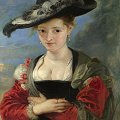 Get
Get  a high-quality picture of
The Straw Hat for your computer or notebook. ‣
The sitter of the picture is probably Susanna Lundent, the sister of
Helene Fourment, the second wife of Rubens. The title of the painting
is "Straw hat" (Le chapeau de paille) from the 17th century, although
the hat is not a straw hat. "Paille" is an old name for the baldachin,
and the painter probably wanted to emphasize by this title the
character of the hat.
a high-quality picture of
The Straw Hat for your computer or notebook. ‣
The sitter of the picture is probably Susanna Lundent, the sister of
Helene Fourment, the second wife of Rubens. The title of the painting
is "Straw hat" (Le chapeau de paille) from the 17th century, although
the hat is not a straw hat. "Paille" is an old name for the baldachin,
and the painter probably wanted to emphasize by this title the
character of the hat.
Portrait of Anne of Austria (1625)
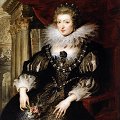 Get
Get  a high-quality picture of
Portrait of Anne of Austria for your computer or notebook. ‣
King Louis XIII found little to admire in the allegorical exuberance of Rubens' Baroque invention in the series painted for her mother, Marie de Medicis. He nonetheless commissioned his own portrait and that of his wife, Anne of Austria, along with a series of sketches and large cartoons of the story of Constantine. Rubens the diplomat-artist responded with rigorously classical portraits, from which every trace of Baroque invention was meticulously excluded. The mother of the future Sun King, Louis XIV, was portrayed in all her feminine majesty. This portrait was executed by the workshop of Rubens.
a high-quality picture of
Portrait of Anne of Austria for your computer or notebook. ‣
King Louis XIII found little to admire in the allegorical exuberance of Rubens' Baroque invention in the series painted for her mother, Marie de Medicis. He nonetheless commissioned his own portrait and that of his wife, Anne of Austria, along with a series of sketches and large cartoons of the story of Constantine. Rubens the diplomat-artist responded with rigorously classical portraits, from which every trace of Baroque invention was meticulously excluded. The mother of the future Sun King, Louis XIV, was portrayed in all her feminine majesty. This portrait was executed by the workshop of Rubens.
The Duke of Buckingham (1625)
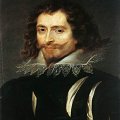 Get
Get  a high-quality picture of
The Duke of Buckingham for your computer or notebook. ‣
George Villiers, the 1st Duke of Buckingham (1592-1628), was a royal favourite and statesman who virtually ruled England during the last years of King James I and the first years of the reign of Charles I. Buckingham was extremely unpopular, and the failure of his aggressive, erratic foreign policy increased the tensions that eventually exploded in the Civil War between the Royalists and the Parliamentarians.
a high-quality picture of
The Duke of Buckingham for your computer or notebook. ‣
George Villiers, the 1st Duke of Buckingham (1592-1628), was a royal favourite and statesman who virtually ruled England during the last years of King James I and the first years of the reign of Charles I. Buckingham was extremely unpopular, and the failure of his aggressive, erratic foreign policy increased the tensions that eventually exploded in the Civil War between the Royalists and the Parliamentarians.
Albert and Nicolaas Rubens (1627)
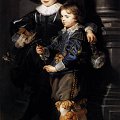 Get
Get  a high-quality picture of
Albert and Nicolaas Rubens for your computer or notebook. ‣
The portraits of Rubens' children - of Clara Serena, Albert and Nicolaas - are entirely personal. In the full-length portrait of Albert and Nicolaas, Rubens's two sons by his first marriage, the most prominent feature is the informal way in which the boys seem to pose, which also bears witness to the painter's great empathy with the children's nature: Nicolaas, the playful child,completely relaxed, and his serious elder brother Albert, a studious bookworm, posing rather self-consciously as a scholar.
a high-quality picture of
Albert and Nicolaas Rubens for your computer or notebook. ‣
The portraits of Rubens' children - of Clara Serena, Albert and Nicolaas - are entirely personal. In the full-length portrait of Albert and Nicolaas, Rubens's two sons by his first marriage, the most prominent feature is the informal way in which the boys seem to pose, which also bears witness to the painter's great empathy with the children's nature: Nicolaas, the playful child,completely relaxed, and his serious elder brother Albert, a studious bookworm, posing rather self-consciously as a scholar.
Portrait of Jan Gaspar Gevartius (1628)
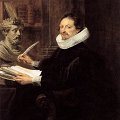 Get
Get  a high-quality picture of
Portrait of Jan Gaspar Gevartius for your computer or notebook. ‣
This is a portrait of Rubens' friend Jan Gaspar Gevaerts (1593-1666). He was a reputable philologist, Neo-Latin poet and historiographer. Characteristically for his intellectual circles he had his name Latinized to Gevartius.
a high-quality picture of
Portrait of Jan Gaspar Gevartius for your computer or notebook. ‣
This is a portrait of Rubens' friend Jan Gaspar Gevaerts (1593-1666). He was a reputable philologist, Neo-Latin poet and historiographer. Characteristically for his intellectual circles he had his name Latinized to Gevartius.
After a stay in Holland and Paris Gevartius became the Registrar of the city of Antwerp. In this function he was in charge of official ceremonies in the city and in 1635 helped Rubens with the "Pompa Introitus Ferdinandi", one of Rubens most impressive projects.
Rubens here intends to represent his friend's humanist attitude: he is sitting at his desk, with a bust of the Roman Emperor and philosopher Marcus Aurelius, on whom he wrote an unpublished commentary.
The painting is dated around 1628. The composition of the work is not Baroque, but fits more easily into the 16th-century tradition of homely portraits of humanists.
The Fur ('Het Pelsken') (1630)
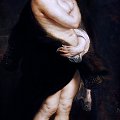 Get
Get  a high-quality picture of
The Fur ('Het Pelsken') for your computer or notebook. ‣
In this painting the artist portrayed his second wife, Helena Fourment nude but for a fur. This was certainly his favourite among the many paintings exhibiting her undeniable charms. At all events, he refused to part with Het Pelsken. In tones worthy of Titian, he painted Helena with curly hair, her nipples erect, her nudity barely concealed by a fur wrap better suited to her husband's bulk than her own. Her expression is difficult to read: is her mutinous air intended as a provocation, or was she simply anxious to wrap herself up against the cold?
a high-quality picture of
The Fur ('Het Pelsken') for your computer or notebook. ‣
In this painting the artist portrayed his second wife, Helena Fourment nude but for a fur. This was certainly his favourite among the many paintings exhibiting her undeniable charms. At all events, he refused to part with Het Pelsken. In tones worthy of Titian, he painted Helena with curly hair, her nipples erect, her nudity barely concealed by a fur wrap better suited to her husband's bulk than her own. Her expression is difficult to read: is her mutinous air intended as a provocation, or was she simply anxious to wrap herself up against the cold?
Helena Fourment (1632)
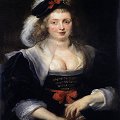 Get
Get  a high-quality picture of
Helena Fourment for your computer or notebook. ‣
In 1630 Rubens returned to Antwerp from his diplomatic mission in England. His two sons were now twelve and sixteen, and he himself was over fifty. Yet the young woman he was now to marry, Helena Fourment, was no older than his elder son. She was, in the words of the Cardinal-Infante Fernando, "the most beautiful woman in Antwerp". She was the younger daughter of the silk and tapestry-merchant, Daniel Fourment, and sister to the Suzanne Fourment whose delightful portrait Rubens had painted some years before. Rubens explained himself to Peiresc: "I decided to remarry, for I have never been attracted to the abstinent life of the celibate, and I told myself that, though we should award the crown to continence, we may nevertheless enjoy legitimate pleasures and give thanks for them. I have chosen a young woman of good but bourgeois family, though everyone sought to convince me to make a court marriage. But I was fearful of a vice inbred in the nobility, and especially prevalent among noble women: vanity. So I chose someone who would never have to blush at finding me brush in hand. And the truth is, I am too fond of my freedom to exchange it for the embraces of an old woman." Far from blushing, Helena was to inspire some of the most personal and moving of all Rubens' portraits.
a high-quality picture of
Helena Fourment for your computer or notebook. ‣
In 1630 Rubens returned to Antwerp from his diplomatic mission in England. His two sons were now twelve and sixteen, and he himself was over fifty. Yet the young woman he was now to marry, Helena Fourment, was no older than his elder son. She was, in the words of the Cardinal-Infante Fernando, "the most beautiful woman in Antwerp". She was the younger daughter of the silk and tapestry-merchant, Daniel Fourment, and sister to the Suzanne Fourment whose delightful portrait Rubens had painted some years before. Rubens explained himself to Peiresc: "I decided to remarry, for I have never been attracted to the abstinent life of the celibate, and I told myself that, though we should award the crown to continence, we may nevertheless enjoy legitimate pleasures and give thanks for them. I have chosen a young woman of good but bourgeois family, though everyone sought to convince me to make a court marriage. But I was fearful of a vice inbred in the nobility, and especially prevalent among noble women: vanity. So I chose someone who would never have to blush at finding me brush in hand. And the truth is, I am too fond of my freedom to exchange it for the embraces of an old woman." Far from blushing, Helena was to inspire some of the most personal and moving of all Rubens' portraits.
Helena Fourment with her Son Francis (1635)
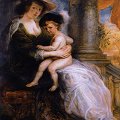 Get
Get  a high-quality picture of
Helena Fourment with her Son Francis for your computer or notebook. ‣
This intensely personal work reveals to us the true Rubens, whose mastery of stroke and palette can convey the sweetness and freshness of youth with incomparable mastery. These brushstrokes, so tenderly applied, reflect an obsession with the beauty of his "Helen".
a high-quality picture of
Helena Fourment with her Son Francis for your computer or notebook. ‣
This intensely personal work reveals to us the true Rubens, whose mastery of stroke and palette can convey the sweetness and freshness of youth with incomparable mastery. These brushstrokes, so tenderly applied, reflect an obsession with the beauty of his "Helen".
Helena Fourment with her Children, Clara, Johanna and Frans (1637)
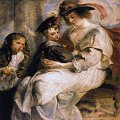 Get
Get  a high-quality picture of
Helena Fourment with her Children, Clara, Johanna and Frans for your computer or notebook. ‣
While commercial production continued apace in Rubens' studio, he reserved his strength for the intimate works that lay closest to his heart, and in particular to those that his young wife continuously inspired. Here his painting becomes deeply moving. There are no greater works in his catalogue than the portrait Helena Fourment with her Children, in which she is seen rosy-complexioned beneath a wide-brimmed feather hat that sets off her round cheeks.
a high-quality picture of
Helena Fourment with her Children, Clara, Johanna and Frans for your computer or notebook. ‣
While commercial production continued apace in Rubens' studio, he reserved his strength for the intimate works that lay closest to his heart, and in particular to those that his young wife continuously inspired. Here his painting becomes deeply moving. There are no greater works in his catalogue than the portrait Helena Fourment with her Children, in which she is seen rosy-complexioned beneath a wide-brimmed feather hat that sets off her round cheeks.
Self-Portrait (1639)
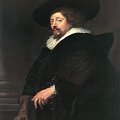 Get
Get  a high-quality picture of
Self-Portrait for your computer or notebook. ‣
This is the last of Rubens's four self-portrait, executed shortly before his death. The portrait shows him dressed in black and wearing a feather hat, like the musketeer he had always been. Beneath the sunken lid glints an eye laden with the experience of life. He seems to have lived a blessed existence and in doing so to have reached a true serenity of heart. Gout alone had his measure. Despite the attentions of the best Brussels doctors, he died of a fierce attack on 30 May 1640.
a high-quality picture of
Self-Portrait for your computer or notebook. ‣
This is the last of Rubens's four self-portrait, executed shortly before his death. The portrait shows him dressed in black and wearing a feather hat, like the musketeer he had always been. Beneath the sunken lid glints an eye laden with the experience of life. He seems to have lived a blessed existence and in doing so to have reached a true serenity of heart. Gout alone had his measure. Despite the attentions of the best Brussels doctors, he died of a fierce attack on 30 May 1640.
Peter Paul Rubens Art
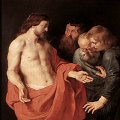
|
|
More
Articles
 Art Encyclopedia A world history of art in articles.
Art Encyclopedia A world history of art in articles.
Baroque
Peter Paul Rubens
Art and life. Biography.
Early mythological paintings.
Late mythological paintings.
Early religious paintings.
Late religious paintings.
Portraits.
Landscapes.
Art
 Art Wallpapers Art image collections for your desktop.
Art Wallpapers Art image collections for your desktop.
Caravaggio Art, $25
(100 pictures)
Rubens Art, $29
(200 pictures)
Rembrandt Art, $25
(160 pictures)

